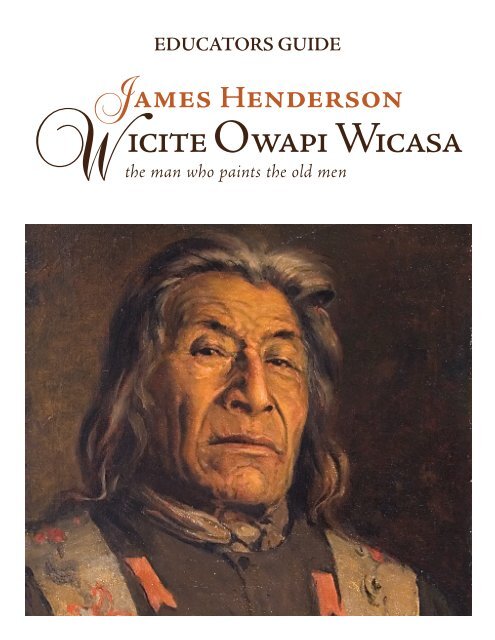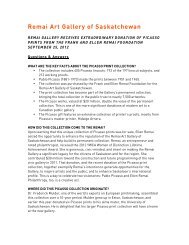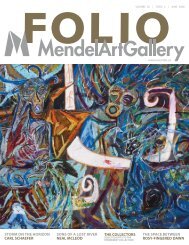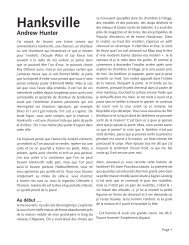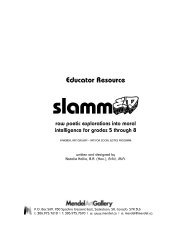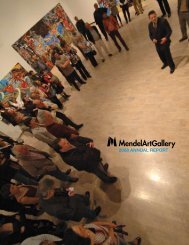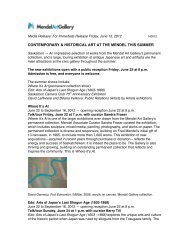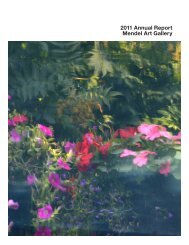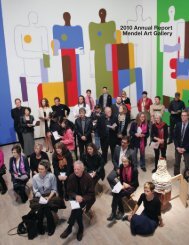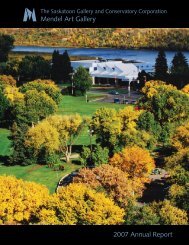DOWNLOAD the Educator's Guide here - Mendel Art Gallery
DOWNLOAD the Educator's Guide here - Mendel Art Gallery
DOWNLOAD the Educator's Guide here - Mendel Art Gallery
You also want an ePaper? Increase the reach of your titles
YUMPU automatically turns print PDFs into web optimized ePapers that Google loves.
EDUCATORS GUIDE
Copyright ©2009 by <strong>the</strong> <strong>Mendel</strong> <strong>Art</strong> <strong>Gallery</strong>.<br />
The <strong>Mendel</strong> <strong>Art</strong> <strong>Gallery</strong> acknowledges <strong>the</strong> collective knowledge of present and past public programming staff in developing this educator’s guide, including Laura<br />
Kinzel, Carol Wylie, Megan Bocking, Kelly Van Damme, Adrian Stimson, Alexandra Badzak, Noreen Neu, Cheryl Meszaros, Neal McLeod, Ray Keighley, and Elizabeth<br />
Ma<strong>the</strong>son. We also credit <strong>the</strong> co-curators of <strong>the</strong> James Henderson exhibition, Dan Ring and Neal McLeod, along with catalogue essay contributors Linda Many Guns,<br />
James Lanigan, and Brigid Ward. Special thanks to communications staff at <strong>the</strong> <strong>Mendel</strong>, particularly Ed Pas and Lindsey Rewuski, for editing and design.<br />
This educators’ guide, exhibition, and o<strong>the</strong>r related programming was made possible through a contribution from <strong>the</strong> Museums<br />
Assistance Program, Department of Canadian Heritage. PotashCorp is <strong>the</strong> title sponsor of James Henderson: Wicite Owapi Wicasa: <strong>the</strong><br />
man who paints <strong>the</strong> old men. The <strong>Mendel</strong>’s annual School Hands-on Tour Program is also sponsored by PotashCorp.<br />
OPEN DAILY<br />
9AM–9PM<br />
FREE ADMISSION<br />
950 SPADINA CRESCENT E.<br />
BOX 569, SASKATOON, SK<br />
CANADA, S7K 3L6<br />
Public Programs: 306-975-8052<br />
(306) 975-7610<br />
MENDEL@MENDEL.CA<br />
WWW.MENDEL.CA
Introduction<br />
The <strong>Mendel</strong> <strong>Art</strong> <strong>Gallery</strong> is pleased to<br />
provide you with this education package<br />
that is designed to supplement your<br />
tour of James Henderson: Wicite Owapi<br />
Wicasa: <strong>the</strong> man who paints <strong>the</strong> old men.<br />
Please visit www.mendel.ca/<br />
henderson for supplemental<br />
material. Portions of <strong>the</strong> upcoming<br />
exhibition catalogue are on this site,<br />
along with printable reproductions,<br />
historical and contemporary context,<br />
interviews, and more. The site can easily<br />
be projected onto a classroom SMART<br />
Board as a teaching aide.<br />
(Cover Image and Above) Sun Walk - Blackfoot,<br />
c. 1924, oil on canvas. Collection of <strong>the</strong> <strong>Mendel</strong><br />
<strong>Art</strong> <strong>Gallery</strong>. Purchased with <strong>the</strong> assistance<br />
of funds from Price Waterhouse, Chartered<br />
Accountants, 1986.
About your Tour<br />
• We recommend that you preview <strong>the</strong> exhibition to best prepare your students.<br />
• The Program <strong>Guide</strong>, assigned to work with your group, will call you a week prior to your visit<br />
to discuss details. We strive to tailor <strong>the</strong> content to meet <strong>the</strong> needs of individual groups and<br />
welcome your ideas.<br />
• Age appropriately, touring groups will explore:<br />
• <strong>the</strong> significance of Henderson as an historical figure in Saskatchewan<br />
• how artists choose <strong>the</strong>ir subject matter<br />
• how an image can evoke multiple memories and associations that vary with each viewer<br />
• landscape and portraiture as art forms<br />
• <strong>the</strong> importance of land to identity<br />
• <strong>the</strong> role that artists play in reflecting individual and community identities<br />
• <strong>the</strong> interaction of settlers with Indigenous peoples<br />
• <strong>the</strong> importance of oral histories to understanding our world<br />
We look forward to learning about art with your group.<br />
Thank you for supporting us in supporting art!<br />
Laura Kinzel<br />
Public Programs Coordinator
How to Use this <strong>Guide</strong>:<br />
• The activities fit into multiple curricula: social studies, language arts, history, media studies, visual<br />
art, and native studies. Flip to <strong>the</strong> section that fits your curriculum needs.<br />
• Each activity is ready-to-use. Do as many as you like, whatever you have time for.<br />
• Each activity is relevant to tour content and can be adapted for most age groups.<br />
• This guide serves as a general introduction to related <strong>the</strong>mes, from learning <strong>the</strong> basics of making<br />
landscapes and portraits to exploring issues around Henderson’s practice. Subjects will be covered<br />
in greater depth during <strong>the</strong> tour.<br />
<strong>Mendel</strong> programs encourage participants to see <strong>the</strong> world in new ways. Our<br />
exhibitions are rated OM—Open Minds Required. We help participants to think<br />
critically about <strong>the</strong> often-confusing world around <strong>the</strong>m, and deliberately challenge<br />
preconceived ideas about art. As a contemporary art gallery, <strong>the</strong> <strong>Mendel</strong> offers<br />
a context for art production that is difficult to replicate in a school environment,<br />
<strong>the</strong>refore providing learners with a unique experience.
Table of Contents<br />
5 About <strong>the</strong> Exhibition<br />
6 Background Information About<br />
James Henderson<br />
8 Curators and Researchers as<br />
Professional <strong>Art</strong> Detectives<br />
Collecting Discussion Activity<br />
Land<br />
10 Introduction to Landscape <strong>Art</strong><br />
The Proverbial Landscape Activity<br />
Categories of Landscape Activity<br />
Looking at <strong>the</strong> Landscape Activity<br />
11 Plein Air Landscape Painting<br />
The Space Between Objects Activity<br />
13 Panoramas<br />
Collective Panorama Activity<br />
14 Identity and Land<br />
Memories of <strong>the</strong> Land Activity<br />
Land Speaks Activity<br />
16 Boosterism<br />
Selling <strong>the</strong> Idea of Place Activity<br />
Boosterism and Colonialism Activity<br />
People<br />
17 Introduction to Portraiture<br />
Portrait Hunt Activity<br />
Verbal/ Dramatic/ Visual Portrait Activity<br />
Symbols Activity<br />
How to Draw a Face Activity<br />
20 Types and Stereotypes<br />
Exploring “Types” Activity<br />
22 Portraits and Photographs<br />
Enlarging Photographs Activity<br />
“Collage You” Activity<br />
Symbols of You Activity<br />
Identity Box Activity<br />
23 Self-Portraits Versus Those<br />
Made by Someone Else<br />
Making Me Activity<br />
24 Who or What Do We Really<br />
See In An Image?<br />
Mirror Portrait Activity<br />
25 Honouring and Monuments<br />
Illuminated Manuscripts Activity<br />
Oral Traditions Activity<br />
Monuments of Memory Activity<br />
27 Related Topics and Resources<br />
for Fur<strong>the</strong>r Research
By connecting Henderson’s portraits of First Nations people and his landscape paintings of<br />
<strong>the</strong> Qu’Appelle Valley and elsew<strong>here</strong> to <strong>the</strong> enduring memories of those who remain and to <strong>the</strong><br />
landscape of our times, we attempt to retrieve memory and connect past and present.<br />
—Dan Ring, Chief Curator, <strong>Mendel</strong> <strong>Art</strong> <strong>Gallery</strong><br />
About <strong>the</strong> Exhibition<br />
This is a major exhibition of <strong>the</strong> portraits,<br />
landscape paintings, and commercial<br />
work of Scottish-born artist James<br />
Henderson (1871 to 1951).<br />
• Henderson was Saskatchewan’s first<br />
professional artist to make a living solely<br />
through his artwork. He is also one of<br />
<strong>the</strong> first nationally and internationally<br />
famous artists in Saskatchewan.<br />
• The exhibition presents Henderson’s<br />
work from <strong>the</strong> Qu’Appelle Valley w<strong>here</strong><br />
he lived, and from Scotland, British<br />
Columbia, Ontario, and Alberta.<br />
• It introduces oral histories of Cree, Blackfoot,<br />
and Dakota peoples based on Henderson’s<br />
portraits of Indigenous peoples.<br />
• Documents including family photos,<br />
samples of his commissioned illuminated<br />
manuscripts, correspondence, and published<br />
articles about his career round out <strong>the</strong> larger<br />
picture of Henderson’s life and passions.<br />
• Photographic source material for<br />
Henderson’s subjects along with a<br />
large photo reproduction of his original<br />
studio reveal his working methods.<br />
• Current video footage of <strong>the</strong> locations<br />
for his landscapes in <strong>the</strong> Qu’Appelle<br />
Valley is juxtaposed with <strong>the</strong><br />
paintings of <strong>the</strong> same locations.<br />
• The exhibition, which fills three of four<br />
main galleries at <strong>the</strong> <strong>Mendel</strong>, includes<br />
a wide variety of two and threedimensional<br />
objects to explore, and will<br />
surely intrigue viewers of all ages.<br />
• With this exhibition <strong>the</strong> <strong>Mendel</strong> has launched<br />
a number of interactive features including<br />
podcasts, and rich web content to gain indepth<br />
access to interviews with key people and<br />
comments on individual artworks on view in <strong>the</strong><br />
gallery space. An interactive SMART Board<br />
will be used as a teaching aide during tours.<br />
The exhibition is co-curated by <strong>Mendel</strong> Chief<br />
Curator Dan Ring and Dr. Neal McLeod,<br />
Associate Professor of Indigenous Studies<br />
at Trent University. The exhibition catalogue<br />
contains essays by several scholars and curators.<br />
An extensive web site for <strong>the</strong><br />
exhibition can be found at<br />
www.mendel.ca/henderson.<br />
James Henderson, Evening, c. 1930<br />
oil on canvas. Collection of <strong>the</strong> <strong>Mendel</strong> <strong>Art</strong> <strong>Gallery</strong>.
Background Information About James Henderson<br />
Below are selected highlights of Henderson’s<br />
life (see <strong>the</strong> web site for more details):<br />
Biography<br />
• James Henderson was born into a middle<br />
class family in Glasgow, Scotland in 1871.<br />
• The son of a sea captain, he took<br />
an apprenticeship in lithographic<br />
printing at age 16.<br />
• He enrolled in night courses at <strong>the</strong><br />
Glasgow School of <strong>Art</strong>, w<strong>here</strong> he was<br />
influenced by <strong>the</strong> Scottish Impressionist<br />
School. Visiting galleries and sketching<br />
from nature nurtured his creative drive.<br />
• In 1900 he married Jean Lang in Glasgow.<br />
• Following employment in London as an<br />
engraver and lithographer, Henderson and<br />
his wife emigrated to Regina in 1910, w<strong>here</strong><br />
he engaged in commercial art assignments.<br />
• Periodic visits to <strong>the</strong> picturesque Qu’Appelle<br />
Valley appealed to Henderson’s artistic<br />
sensibilities, and he relocated with his wife<br />
to Fort Qu’Appelle in 1915 or 1916. The<br />
environment, rich with lakes, dramatic hills,<br />
and meandering coulees probably reminded<br />
<strong>the</strong>m of <strong>the</strong>ir Scottish homeland. They lived<br />
in a house on <strong>the</strong> Qu’Appelle River, 45 miles<br />
east of Regina, for <strong>the</strong> remainder of <strong>the</strong>ir lives.<br />
• Henderson painted his beloved valley in<br />
every season and mood, and lived a quiet<br />
life. Acquaintances described him as a gentle<br />
man with a keen sense of humour, who loved<br />
dogs, music, golf, and visiting friends.<br />
• Henderson died in Regina in 1951, just short of<br />
his 80th birthday. He was buried alongside his<br />
wife, overlooking <strong>the</strong> valley at Fort Qu’Appelle.<br />
About Henderson’s Life<br />
• In addition to painting landscapes, Henderson<br />
also painted portraits. While <strong>the</strong>se include<br />
portraits of Saskatchewan political and<br />
business figures, he more importantly<br />
established a career as a painter of portraits<br />
of Indigenous peoples. T<strong>here</strong> is evidence<br />
that Henderson had a personal relationship<br />
with <strong>the</strong> Indigenous people he painted;<br />
it is thought that a Chief of <strong>the</strong> Standing<br />
Buffalo Reserve near Fort Qu’Appelle named<br />
Henderson as Honorary Chief Wicite Owapi<br />
Wicasa: <strong>the</strong> man who paints <strong>the</strong> old men.<br />
(Researchers have questions about <strong>the</strong> origin<br />
and translation of Henderson’s honorary<br />
Dakota name. The web site and exhibition<br />
catalogue explore this subject in greater detail.)<br />
• Recognizing Henderson’s significant<br />
achievements, <strong>the</strong> University of Saskatchewan<br />
bestowed on him an honorary Doctor of<br />
Laws degree at its spring convocation in<br />
1951. Gordon Snelgrove, Head of <strong>the</strong> <strong>Art</strong><br />
Department, referred to Henderson as <strong>the</strong><br />
“dean of Saskatchewan artists…esteemed<br />
throughout Canada as a painter of first rank.”
Exhibitions and <strong>Art</strong> Career<br />
Henderson’s exhibition history is<br />
lengthy. Below are some highlights.<br />
• His portraits first came to national and<br />
international attention when his work<br />
was included in <strong>the</strong> 1924 and 1925<br />
Canadian arts sections of <strong>the</strong> British<br />
Empire Exhibition in London, England.<br />
• During <strong>the</strong> late 1920s and early 1930s he<br />
exhibited portraits and landscapes in <strong>the</strong><br />
Annual Exhibition of Canadian <strong>Art</strong> at <strong>the</strong><br />
National <strong>Gallery</strong> of Canada in Ottawa, alongside<br />
members of <strong>the</strong> Group of Seven and Emily Carr.<br />
• The National <strong>Gallery</strong> of Canada purchased<br />
one portrait and two landscapes<br />
by him, during this period.<br />
• In 1925 <strong>the</strong> University of Saskatchewan<br />
commissioned Henderson to paint twelve<br />
portraits of Indigenous peoples.<br />
• In <strong>the</strong> 1920s and 1930s he regularly<br />
exhibited in Montreal, Toronto, Regina,<br />
and London, England.<br />
• Henderson travelled in Western Canada,<br />
painting portraits of Indigenous peoples and<br />
exhibiting his works in <strong>the</strong> principal cities.<br />
• In addition to portraits and Qu’Appelle<br />
Valley landscapes, his oeuvre contains<br />
landscapes of British Columbia, Alberta,<br />
Ontario, and Scotland.<br />
• Henderson sold most of his work directly<br />
from his studio in Fort Qu’Appelle.<br />
James Henderson when he first came to <strong>the</strong> Fort,<br />
c. 1915–16. Photographer unknown. Courtesy of<br />
Diane Morris.
Curators and Researchers as<br />
Professional <strong>Art</strong> Detectives<br />
This is <strong>the</strong> first exploration of this magnitude<br />
into <strong>the</strong> life and work of James Henderson. The<br />
exhibition curators wanted to bring toge<strong>the</strong>r<br />
as much of his vast body of work in one<br />
location as possible. In addition to celebrating<br />
Henderson’s prolific career, curators also sought<br />
to examine <strong>the</strong> attitudes of <strong>the</strong> time and <strong>the</strong><br />
impact of his legacy today. This process required<br />
much research over several years from myriad<br />
sources. The result of all this research is an<br />
expansive, inclusive, and remarkable exhibition.<br />
• Substantial new information was discovered,<br />
both fascinating and at times contradictory.<br />
(Touring groups will explore this more fully.)<br />
• T<strong>here</strong> are some exhibition and<br />
archival records, and many anecdotal<br />
remembrances about <strong>the</strong> man.<br />
• No personal journals, diaries, or letters<br />
were found that could give an impression<br />
of his thoughts and ambitions.<br />
• A few quotes from newspaper articles written<br />
about him during or after his life offer some<br />
glimpse into his opinions on art and society.<br />
• Owners of Henderson’s paintings were<br />
sought out. Some readily contributed<br />
works for <strong>the</strong> project, and o<strong>the</strong>rs had to be<br />
convinced about <strong>the</strong> merits of parting with<br />
<strong>the</strong>ir treasures for loan to <strong>the</strong> exhibition.<br />
• T<strong>here</strong> are many more works known<br />
to be in existence that could not<br />
be included in <strong>the</strong> show.<br />
• Curators travelled to places that<br />
Henderson lived and worked, including<br />
Scotland, to piece toge<strong>the</strong>r his life.<br />
• Family photos were revealed<br />
after much word-of-mouth.<br />
• Longtime residents in <strong>the</strong> Qu’Appelle<br />
Valley helped to situate <strong>the</strong> actual locations<br />
that Henderson painted in <strong>the</strong> valley<br />
and provide a history of <strong>the</strong> area.<br />
• Interviews with surviving family members and<br />
acquaintances of <strong>the</strong> subjects in Henderson’s<br />
portraits of Indigenous peoples clarify <strong>the</strong>ir<br />
names and provide a valuable oral history.<br />
• Connections to significant historical figures<br />
abound, including portraits of Chief Sitting<br />
Bull who battled at <strong>the</strong> Little Big Horn River,<br />
Chief Crowfoot who was <strong>the</strong> head chief<br />
of <strong>the</strong> Blackfoot Confederacy and had a<br />
prominent role in Treaty 7 negotiations,<br />
and Honorable Hugh Richardson who<br />
presided over <strong>the</strong> trial of Louis Riel.
Collecting Discussion Activity<br />
The Henderson exhibition was drawn from<br />
private and public collections of artwork,<br />
including <strong>the</strong> <strong>Mendel</strong>’s own Permanent<br />
Collection. Introduce <strong>the</strong> notion of collecting<br />
by asking students <strong>the</strong> following:<br />
• Why do some people like to collect things?<br />
(For example: we like what we collect,<br />
collecting is challenging, we can show off<br />
our efforts, it’s prestigious, collecting things<br />
no one else has is fun, we earn money by<br />
reselling it, it’s an investment, we can increase<br />
our knowledge about a topic, we enjoy<br />
talking to o<strong>the</strong>rs who share our interests).<br />
• Do you collect? What?<br />
• W<strong>here</strong> do you keep it?<br />
• How do you decide what goes<br />
into your collection?<br />
• Who sees it?<br />
Consider asking students to bring in<br />
elements from <strong>the</strong>ir collections for<br />
“show and tell.”<br />
Collection of animals. Photo by Laura Kinzel.
Land<br />
Introduction to Landscape <strong>Art</strong><br />
The landscape is all around us. It is something<br />
that we take for granted and consequently, rarely<br />
take <strong>the</strong> time to appreciate. In o<strong>the</strong>r words,<br />
familiarity can produce apathy. The activities<br />
below introduce students to landscape art.<br />
The Proverbial Landscape Activity<br />
Begin by asking students what landscape<br />
art is (works of art that show features<br />
of <strong>the</strong> natural environment).<br />
• Why would an artist use <strong>the</strong> landscape as<br />
subject matter? (to capture awe and wonder,<br />
it’s ever-changing, artists can experiment<br />
with materials, it’s a fun environment<br />
to work in, artists can scientifically/<br />
geographically/biologically study a place,<br />
<strong>the</strong>y can express a spiritual connection,<br />
artists can learn perspective, etc.)<br />
• Ask students to begin <strong>the</strong> landscape unit by<br />
painting a landscape, to record <strong>the</strong>ir idea<br />
of a landscape painting. Do not give <strong>the</strong>m<br />
any motivational cues. Keep this painting<br />
as a record to compare to a painting <strong>the</strong>y<br />
will produce in <strong>the</strong> classroom after <strong>the</strong><br />
gallery visit. This first work will likely be a<br />
cliché landscape that can be questioned<br />
throughout <strong>the</strong> learning process.<br />
10<br />
Categories of Landscape Activity<br />
Collect reproductions, pictures, photographs,<br />
poems, stories, etc., about <strong>the</strong> landscape.<br />
• Brainstorm with <strong>the</strong> students about how<br />
many different kinds of landscape <strong>the</strong>y see<br />
(barren, rocky, forests, stormy, morning,<br />
seascape, mountains, moody, etc.).<br />
• Develop some categories of landscape<br />
paintings (prairie, with buildings, with people,<br />
close-up, panorama, with animals, etc.).<br />
• What is <strong>the</strong> difference between real<br />
life landscape and pictures? (no<br />
smells, sounds, one point of view)<br />
Looking at <strong>the</strong> Landscape Activity<br />
Outside in nature or looking at reproductions:<br />
• Ask students to look for directions in<br />
<strong>the</strong> environment by noticing horizontal,<br />
vertical and diagonal lines.<br />
• Challenge students to “stretch” <strong>the</strong>ir<br />
eyes. “Find something outside you<br />
haven’t noticed before and draw it.”<br />
• Ask <strong>the</strong>m to investigate textures in<br />
a landscape by taking rubbings of<br />
leaves, bark, and o<strong>the</strong>r surfaces.
Plein Air Landscape Painting<br />
T<strong>here</strong> is ample evidence that James Henderson<br />
painted many of his landscapes on site outdoors.<br />
Plein air is a French phrase meaning “open<br />
air.” Plein air painting, or painting out of doors,<br />
was not common until <strong>the</strong> mid-19th century,<br />
after transportation improved and lightweight<br />
portable equipment was invented (including<br />
tubes for oil paint). These changes facilitated <strong>the</strong><br />
growing desire by artists to paint directly from<br />
nature. Plein air was popularised by <strong>the</strong> French<br />
Impressionists, especially Monet, whose work<br />
captured <strong>the</strong> ever-changing effects of natural<br />
light through active brushstrokes and vibrant<br />
colour. Because <strong>the</strong>y could spontaneously<br />
respond directly to subtle mood and atmospheric<br />
changes, plein air artists were able to develop<br />
new techniques such as rapid brush-work.<br />
Unpredictable wea<strong>the</strong>r, rapidly changing light,<br />
paint that dries too quickly or slowly, even insects<br />
are some of <strong>the</strong> challenges that plein air artists<br />
face—but even <strong>the</strong>se are just part of <strong>the</strong> fun!<br />
Henderson preferred an “impressionist” style<br />
when painting his landscapes—whe<strong>the</strong>r<br />
<strong>the</strong>y depicted <strong>the</strong> Qu’Appelle Valley w<strong>here</strong><br />
he lived most of his life, reflected Scotland<br />
w<strong>here</strong> he was born, or recorded his travels<br />
through British Columbia, Alberta, or Ontario.<br />
His landscapes give a general impression<br />
of <strong>the</strong> scene and captures a mood, through<br />
active brush strokes, blended colours,<br />
and scant attention to fine details.<br />
11<br />
James Henderson, Road to <strong>the</strong> Lake, 1935, oil on canvas.<br />
Collection of James Lanigan.
The Space Between Objects Activity<br />
In this activity students will go outdoors to work<br />
en plein air using any colourful drawing or painting<br />
material. They can use a viewfinder (explained<br />
below) to isolate a section of <strong>the</strong> landscape. If<br />
<strong>the</strong> wea<strong>the</strong>r is poor, this activity can be done<br />
from photographs that feature large foreground<br />
trees that frame <strong>the</strong> scene (try a Google image<br />
search [trees, landscape] or old calendars).<br />
• Begin by referring to <strong>the</strong> Henderson painting<br />
Road to <strong>the</strong> Lake (see page 11) or o<strong>the</strong>r<br />
reproductions. See how <strong>the</strong> large trees frame<br />
<strong>the</strong> landscape. The close-up, detailed trees<br />
in <strong>the</strong> foreground create contrast with <strong>the</strong><br />
smaller and more distant elements in <strong>the</strong><br />
landscape. The illusion of depth has been<br />
created by having large detailed elements in<br />
<strong>the</strong> foreground, and shapes that gradually<br />
get smaller as <strong>the</strong>y recede into space.<br />
• Introduce <strong>the</strong> idea that one way to incorporate<br />
trees into a scene is to start with <strong>the</strong><br />
background and add <strong>the</strong> trees on top of<br />
it. But a more interesting way is to start by<br />
making <strong>the</strong> big trees in <strong>the</strong> foreground, <strong>the</strong>n<br />
filling in <strong>the</strong> background elements between<br />
<strong>the</strong> trees. That way, <strong>the</strong> space between <strong>the</strong><br />
objects (negative space) is as interesting as<br />
<strong>the</strong> objects <strong>the</strong>mselves. Explain that this is <strong>the</strong><br />
approach you would like <strong>the</strong> students to take.<br />
• To draw <strong>the</strong> scene, students first sketch <strong>the</strong><br />
main parts in pencil, <strong>the</strong>n add colour with<br />
pastels or paint. Pay attention to <strong>the</strong> space<br />
between <strong>the</strong> leaves, branches, and trees<br />
(negative space). Also notice <strong>the</strong> subtle<br />
visual changes in <strong>the</strong> sky. If <strong>the</strong> drawing<br />
includes water, be sure to reflect <strong>the</strong> clouds<br />
12<br />
on its surface. Carefully look at <strong>the</strong> lights<br />
and darks in <strong>the</strong> scene and choose/blend<br />
<strong>the</strong> colours and materials accordingly.<br />
Generally, light colours advance and dark<br />
colours recede. Highlights and shadows<br />
can add depth. Are those shadows really<br />
black, or can you see o<strong>the</strong>r colours, too?<br />
Tip to using viewfinders<br />
Sometimes <strong>the</strong> thought of drawing or painting<br />
an entire landscape can seem overwhelming.<br />
If students hold a viewfinder up and peer<br />
through it, <strong>the</strong>y can isolate <strong>the</strong> more interesting<br />
parts of <strong>the</strong> landscape. Empty slide mounts<br />
or hand-cut windows in stiff paper can both<br />
function as viewfinders. Practice holding<br />
it at different distances from <strong>the</strong> face.<br />
Using a viewfinder to isolate sections of <strong>the</strong> landscape.
Panoramas<br />
A panorama is a two-dimensional work<br />
of art that depicts a viewpoint of 180<br />
degrees or more. In some of his paintings<br />
Henderson depicted vast views of <strong>the</strong><br />
landscape. While we can debate whe<strong>the</strong>r<br />
some of Henderson’s paintings technically<br />
are panoramas, we can certainly agree that<br />
many reflected broad stretches of land.<br />
13<br />
Collaborative Panorama Activity<br />
Have students sit outdoors or in <strong>the</strong> classroom<br />
in a semi circle.<br />
• Using viewfinders (see The Space Between<br />
Objects Activity on page 12) and <strong>the</strong> devices<br />
of perspective to draw <strong>the</strong> landscape, ask<br />
each student to depict <strong>the</strong> small portion of<br />
<strong>the</strong> panoramic space <strong>the</strong>y see through <strong>the</strong>ir<br />
viewfinder. You could mark out <strong>the</strong> range of<br />
space for each student to view.<br />
• Pin all <strong>the</strong> drawings toge<strong>the</strong>r on a long wall to<br />
re-create <strong>the</strong> larger panoramic view. It’s okay<br />
if some images overlap and shift perspective.
Identity and Land<br />
W<strong>here</strong> we are born, w<strong>here</strong> we grow up, and<br />
w<strong>here</strong> we move to—whe<strong>the</strong>r by choice or<br />
circumstance—all influence who we become.<br />
In his essay for <strong>the</strong> exhibition catalogue, Neal<br />
McLeod discusses how a lifestyle of hunting,<br />
trapping, fishing, ga<strong>the</strong>ring plants, and <strong>the</strong><br />
changing rhythms of <strong>the</strong> seasons sustained <strong>the</strong><br />
livelihood of Indigenous peoples; land, humans,<br />
and animals were deeply intertwined. When a<br />
dam built in <strong>the</strong> Qu’Appelle Valley resulted in<br />
flooding, <strong>the</strong> landscape was forever altered,<br />
and by extension so too were <strong>the</strong> peoples of<br />
<strong>the</strong> region. For more information, McLeod’s<br />
interviews with elders and knowledge keepers<br />
from <strong>the</strong> valley can be accessed at www.<br />
mendel.ca/henderson, read in <strong>the</strong> exhibition<br />
catalogue, or previewed in <strong>the</strong> exhibition.<br />
14<br />
James Henderson, The Marsh, 1918, oil on canvas.<br />
Collection of James Lanigan.<br />
The Marsh, by James Henderson, depicts <strong>the</strong><br />
marsh at <strong>the</strong> end of Pasqua Lake before <strong>the</strong><br />
building of <strong>the</strong> dam in Fort Qu’Appelle in 1943<br />
caused extensive flooding. Prior to this flooding<br />
<strong>the</strong> marsh was a traditional Indigenous hunting<br />
area and was also used by settlers for <strong>the</strong> same<br />
purpose. This is a contested issue today and<br />
negotiations are still under way to compensate<br />
members of <strong>the</strong> Pasqua reserve for <strong>the</strong> flooding.
Memories of <strong>the</strong> Land Activity<br />
Ask students to collect stories surrounding<br />
family origins from family members.<br />
• W<strong>here</strong> have <strong>the</strong>ir ancestors lived,<br />
how did <strong>the</strong> land influence <strong>the</strong>ir<br />
lifestyles, and what has changed?<br />
• Share <strong>the</strong>se stories in class and discuss <strong>the</strong><br />
different relationships <strong>the</strong> students’ ancestors<br />
may have expressed about <strong>the</strong> land.<br />
• Ask students to draw one of <strong>the</strong><br />
stories that helped <strong>the</strong>m to understand<br />
<strong>the</strong> world in a new way.<br />
Check out <strong>the</strong> Homelands section<br />
of <strong>the</strong> ARTSask web site for related<br />
responses by o<strong>the</strong>r artists, www.artsask.<br />
ca, or http://artsask.uregina.ca/en/<br />
collections/<strong>the</strong>mes/homelands.<br />
1<br />
Land Speaks Activity<br />
Obtain a copy of <strong>the</strong> short children’s book,<br />
Qu’Appelle (see below) by David Bouchard<br />
(paintings by Michael Lonechild). It recounts a<br />
famous love story about a young brave who must<br />
leave his betro<strong>the</strong>d to lead a war party against<br />
<strong>the</strong> Blackfoot. Broken hearted, his betro<strong>the</strong>d<br />
dies. Cree elders say you can still hear <strong>the</strong> brave<br />
searching for his girlfriend. Mohawk poet Pauline<br />
Johnson tells ano<strong>the</strong>r version of <strong>the</strong> story that<br />
educators could also investigate with students.<br />
• After reading <strong>the</strong> book, ask students to interview<br />
a place. This place could be a personification<br />
of <strong>the</strong>ir school, a favorite hiding place, <strong>the</strong>ir<br />
backyard, bedroom, closet, grandparents’<br />
kitchen, etc. Generate a list of questions with<br />
<strong>the</strong> class for <strong>the</strong>m to use during <strong>the</strong>ir interviews.
Boosterism<br />
James Henderson, Winnipeg, under <strong>the</strong> proposed scheme, will become one of <strong>the</strong> most superb capitols of<br />
Canada, c. 1913, newspaper clipping. Courtesy of Diane Morris, Fort Qu’Appelle, Saskatchewan.<br />
In <strong>the</strong> early twentieth century <strong>the</strong> prairie was<br />
promoted as a great place in which to live and<br />
invest. Images that promoted <strong>the</strong> benefits of<br />
Canadian settlement were widely distributed to<br />
European audiences. These images were often<br />
exaggerated and excessively optimistic. James<br />
Henderson played a role in Boosterism through<br />
his commercial work, as demonstrated by his<br />
imagined plan for <strong>the</strong> city of Winnipeg and o<strong>the</strong>r<br />
commissions. The topic of prairie Boosterism<br />
and Henderson’s role are discussed more<br />
extensively in Dan Ring’s catalogue essay.<br />
1<br />
Selling <strong>the</strong> Idea of Place Activity<br />
Ask students to think about how <strong>the</strong>y can “sell”<br />
<strong>the</strong> idea that <strong>the</strong>ir school is <strong>the</strong> best in <strong>the</strong> city<br />
to attend. They will make a poster to entice<br />
future students. Exaggerate, celebrate, brag,<br />
and ignore <strong>the</strong> negatives.<br />
Boosterism and Colonialism Activity<br />
Older students can investigate <strong>the</strong> larger role<br />
that Boosterism played in colonialism and <strong>the</strong><br />
displacement of Indigenous peoples.
People<br />
Introduction to Portraiture<br />
The portraits painted by James Henderson<br />
were ei<strong>the</strong>r commissioned by o<strong>the</strong>rs, or were<br />
done because he was interested in <strong>the</strong> subject<br />
and could earn a living by selling his work.<br />
Portrait Hunt Activity<br />
Begin by asking students “What is a portrait?”<br />
Traditionally a portrait is defined as a<br />
representation of a person, especially of <strong>the</strong> face,<br />
but <strong>the</strong>re are grey areas in <strong>the</strong> definition. Clearly<br />
when someone represents himself or herself,<br />
developed from life, it is a portrait. Some people<br />
argue that a representation of a person long dead<br />
is not a true portrait as it is done from imagination<br />
and <strong>the</strong> evidence of accuracy is sketchy. What<br />
about when an actor portrays someone else in<br />
a movie? Is a representation of any living thing a<br />
portrait, such as a painting of a dog or a tree?<br />
• Students will collect portraits from many<br />
sources and of diverse people. Display<br />
<strong>the</strong> images and make a list of what<br />
information can be gleaned from portraits<br />
(age of <strong>the</strong> sitter, social status, nationality,<br />
state of mind, occupation, tastes).<br />
1<br />
• What are <strong>the</strong> functions of a portrait?<br />
A portrait can function as:<br />
• a historical document (hairstyles,<br />
clo<strong>the</strong>s fashion, a record of what a<br />
historical person looked like, etc.),<br />
• a symbol (<strong>the</strong> Queen’s photo in<br />
many classrooms, a Christ figure),<br />
• a statement about “<strong>the</strong> state of<br />
things” (Van Gogh’s self portrait),<br />
• a study in composition<br />
(Picasso’s portraits),<br />
• a means of self-exploration<br />
(Rembrandt’s self-portraits),<br />
• a representation of familial<br />
bonds (Mary Cassatt’s paintings<br />
of mo<strong>the</strong>rs with children)<br />
• a record of social status (painting<br />
by James Henderson of a judge,<br />
on view in <strong>the</strong> Saskatchewan<br />
Legislative Building in Regina)<br />
• and more.<br />
• Using <strong>the</strong> collected images, cut and paste<br />
portraits with conflicting information,<br />
such as <strong>the</strong> hands of a model, head of a<br />
businessman, and clo<strong>the</strong>s of a rock star.
Verbal/Dramatic/Visual Portrait Activity<br />
Ask students to select a real person that <strong>the</strong>y are<br />
familiar with, and have <strong>the</strong>m write a description of<br />
that person’s physical features and personality.<br />
• Ask students to act out a portrait of that person.<br />
• Then instruct students to draw or paint a<br />
portrait of that person. They should include<br />
objects in <strong>the</strong>ir picture that tell more about <strong>the</strong><br />
person, and keep in mind colour symbolism and<br />
distinguishing features.<br />
1<br />
Symbols Activity<br />
A symbol is something which is itself and yet<br />
stands for something else or evokes a meaning<br />
beyond itself. A portrait can be a symbol in itself,<br />
and it can use symbols to convey information<br />
about <strong>the</strong> sitter. Referring to portraits of important<br />
people, ask students what kind of character is<br />
implied in each portrait.<br />
• Discuss <strong>the</strong> role that gesture, stance, and<br />
expression plays in informing <strong>the</strong> viewer.<br />
• How might students act out concepts such<br />
as authority, genius, spirituality, stupidity or<br />
wealth?<br />
• What symbols are frequently used in our<br />
culture?<br />
• Have students draw symbolic self-portraits of<br />
what <strong>the</strong>y want to be 20 years from now, using<br />
props and symbols to identify <strong>the</strong> profession.
How to Draw a Face Activity<br />
This basic activity teaches <strong>the</strong> proportions of a<br />
face. Reinforce that <strong>the</strong>se are guidelines, that<br />
every face is a little bit different. Ask students to:<br />
• Draw an egg shape for <strong>the</strong> head.<br />
• Draw a light line half way down across <strong>the</strong> face<br />
to mark <strong>the</strong> eyes; eyes are half way between top<br />
of head and chin (or lower on young children).<br />
• Divide this line into five sections to show w<strong>here</strong><br />
eyes go; eyes are in <strong>the</strong> second and fourth<br />
sections. Eyes are like skinny, lopsided lemons,<br />
tilted up at <strong>the</strong> outside corners. T<strong>here</strong> is an eye<br />
length across <strong>the</strong> nose.<br />
• The bottom of <strong>the</strong> nose is half way between<br />
eyes and chin. The nose is like a flat, curvy “M”<br />
with “C’s” on ei<strong>the</strong>r side.<br />
• A line half way between <strong>the</strong> nose and chin<br />
marks <strong>the</strong> bottom of <strong>the</strong> mouth; <strong>the</strong> mouth<br />
is closer to <strong>the</strong> nose than <strong>the</strong> chin. The line<br />
between <strong>the</strong> lips is a bit like a flattened “M.”<br />
• Now consider shading. Observe w<strong>here</strong> shadows<br />
are around <strong>the</strong> nose, cheeks, eyes, etc.<br />
• Add hair. Look for <strong>the</strong> basic shape and <strong>the</strong>n<br />
work on highlights and shadows, adding a few<br />
strands for emphasis.<br />
• Shoulders are a head’s width on each side.<br />
1
Types and Stereotypes<br />
James Henderson lived and painted during a time<br />
when <strong>the</strong> dominant culture was often blatantly<br />
racist. Like many settlers of his age, Henderson<br />
seemed to believe that “<strong>the</strong> Indian” was a<br />
vanishing race, and <strong>the</strong>refore he romanticized<br />
<strong>the</strong>ir past in his depictions of <strong>the</strong>m.<br />
“<strong>Art</strong>ists who came to North America<br />
from Europe were <strong>the</strong> first to make<br />
visual images of aboriginal people for<br />
Europeans who knew little of <strong>the</strong> new<br />
world and its people. Many of <strong>the</strong> artists<br />
<strong>the</strong>mselves knew little of <strong>the</strong> new world<br />
and its people. The images <strong>the</strong>y created<br />
of aboriginal people did not accurately<br />
reflect how <strong>the</strong>se people saw <strong>the</strong>mselves.<br />
These pictures depicted how Europeans<br />
saw <strong>the</strong>m. Many of <strong>the</strong>se images were<br />
romantic notions of aboriginal people<br />
which really did not exist.” (Claiming<br />
Ourselves: iyiniwak anohc, educators<br />
guide, Neal McLeod and Elizabeth<br />
Ma<strong>the</strong>son, <strong>Mendel</strong> <strong>Art</strong> <strong>Gallery</strong>, 1996)<br />
While James Henderson spent time getting to<br />
know <strong>the</strong> local band members, and apparently<br />
was given an honourary Dakota name, curators<br />
today feel that several of his portraits contain<br />
confusing information about <strong>the</strong> subjects, such<br />
as Dakota headdresses on Blackfoot people,<br />
people in portraits who o<strong>the</strong>rs today say do not<br />
look like <strong>the</strong> person depicted, etc. (Tour groups<br />
will explore this more fully during <strong>the</strong>ir visits.) As<br />
we find errors or inconsistencies around some<br />
of Henderson’s portraits of Indigenous peoples,<br />
what are we, <strong>the</strong>n, to think about every portrait<br />
that he painted?<br />
20<br />
Linda Many Guns has written an essay in <strong>the</strong><br />
catalogue about peoples from <strong>the</strong> Blackfoot<br />
Nation/Blackfoot Confederacy who are depicted<br />
in Henderson’s portraits. Excerpts are on <strong>the</strong><br />
exhibition web site and within <strong>the</strong> exhibition itself.<br />
James Henderson, The Philosopher, A Sioux Indian, no<br />
date, oil on canvas. Collection of <strong>the</strong> MacKenzie <strong>Art</strong><br />
<strong>Gallery</strong>, University of Regina Collection. Gift of Mr. Norman<br />
MacKenzie.
Exploring “Types” Activity<br />
James Henderson painted many portraits.<br />
Sometimes he identified <strong>the</strong> name of <strong>the</strong><br />
sitter in <strong>the</strong> title, and o<strong>the</strong>r times he (or o<strong>the</strong>rs)<br />
titled his paintings “Sioux Indian” or “Female<br />
Indian Head.” This can imply a kind of generic<br />
handling of those sitters. This is especially<br />
troublesome given <strong>the</strong> colonial enterprise that<br />
worked to assimilate Indigenous people into<br />
settler culture, and <strong>the</strong> treatment of Indigenous<br />
people as a vanishing race. Ask students how<br />
<strong>the</strong>y would feel if someone painted a likeness<br />
of <strong>the</strong>m and <strong>the</strong>n titled it “Student Head.”<br />
Would <strong>the</strong> image still be of <strong>the</strong>m, and what<br />
o<strong>the</strong>r messages might it give to viewers?<br />
The above conversation leads to a<br />
discussion of “types” and stereotypes.<br />
• Ask students to ga<strong>the</strong>r pictures of a<br />
wide variety of character types.<br />
• Then ask <strong>the</strong>m to establish categories of<br />
“types”; some may be ambiguous and o<strong>the</strong>rs<br />
may be more subjective. Cartoon characters<br />
and caricatures can be part of this conversation.<br />
• Ask students to choose a “type” of person and<br />
draw it according to accepted conventions<br />
(saint with halo, villain in black, grandma with<br />
glasses, nerd with unfashionable clothing).<br />
• Display <strong>the</strong>se works and ask students<br />
to guess what “type” is represented<br />
and explain <strong>the</strong>ir reasoning.<br />
21<br />
• Now discuss <strong>the</strong> usefulness of this kind<br />
of “typing” and <strong>the</strong> in<strong>here</strong>nt assumptions.<br />
In what ways is “typing” helpful, and<br />
in what ways is it damaging?<br />
• Pictures do not show exactly <strong>the</strong> whole<br />
truth; ask students if <strong>the</strong>y have seen things<br />
on television that aren’t completely true.<br />
What about a game, movie or toy that<br />
isn’t as exciting as <strong>the</strong> commercial?<br />
• Move this discussion forward by allowing<br />
students to talk about <strong>the</strong>ir diverse ethnic<br />
backgrounds. How do <strong>the</strong>y feel stereotyped?<br />
What effect does this have on <strong>the</strong>m?
Portraits and Photographs<br />
To paint his portraits, James Henderson often<br />
enlarged photographs using a grid system.<br />
Enlarging Photographs Activity<br />
Teach students how to enlarge a portrait.<br />
• Draw a grid of 1.27 cm squares<br />
(½ inch) on top of a photo.<br />
• Then draw a grid of 2.54 cm squares<br />
(1-inch) on ano<strong>the</strong>r piece of paper.<br />
• Now copy what you see in each square<br />
of <strong>the</strong> photo onto <strong>the</strong> big paper.<br />
“Collage You” Activity<br />
In this activity students will collage toge<strong>the</strong>r<br />
photographs of various aspects of <strong>the</strong>mselves<br />
to present a unique self-portrait. Images<br />
can include close-ups of body parts, long<br />
shots, and photos of props that tell more<br />
about <strong>the</strong> student. Black and white prints<br />
from digital photos would work fine.<br />
• Students will collage <strong>the</strong>ir fragments<br />
into a long horizontal format to create<br />
a landscape-like narrative.<br />
• Consider how ordering and layout<br />
changes <strong>the</strong> message.<br />
22<br />
Symbols of You Activity<br />
In this activity students will draw symbols<br />
of <strong>the</strong>mselves on an enlarged portrait.<br />
• A school photograph can be enlarged using a<br />
computer or a photocopier. Enlarging provides<br />
more surface to draw upon. Ask students to<br />
enhance <strong>the</strong> enlarged image with symbols<br />
of <strong>the</strong>mselves to explore <strong>the</strong>ir inner selves.<br />
Identity Box Activity<br />
The most meaningful and successful<br />
artworks come when <strong>the</strong> artist has direct<br />
experience with <strong>the</strong> subject or <strong>the</strong>me. This<br />
activity explores <strong>the</strong> use of visual symbols<br />
to tell personal histories and stories.<br />
• Students will first discuss and list various<br />
groups to which <strong>the</strong>y belong (family,<br />
sports, religious, musical, school, age,<br />
ethnicity, jobs, fan clubs, hobbies, etc).<br />
• Students will <strong>the</strong>n expand <strong>the</strong>ir list to include<br />
more abstract ideas that relate to <strong>the</strong>ir<br />
identity (people <strong>the</strong>y admire or dislike, current<br />
events, issues, favourite places to go).<br />
• Next <strong>the</strong>y will collect symbols from any source,<br />
and may alter <strong>the</strong>m to change <strong>the</strong>ir meaning.<br />
These symbols can be put into individual<br />
boxes and when examined will be able to<br />
communicate about <strong>the</strong> maker’s identity.<br />
• What ideas and symbols are common to<br />
<strong>the</strong> class as a whole? Would people outside<br />
<strong>the</strong> class understand <strong>the</strong>se symbols?<br />
How have different symbols been used to<br />
explain <strong>the</strong> same ideas? Did some symbols<br />
stand for multiple ideas even when <strong>the</strong><br />
student only intended one meaning?
Self-Portraits versus Those Made by Someone Else<br />
Some people are concerned that Henderson<br />
was a non-Indigenous person painting portraits<br />
of Indigenous people. They question how much<br />
he truly knew about his subjects and his intent<br />
behind making <strong>the</strong> portraits. While his homeland<br />
of Scotland experienced a colonial past similar<br />
to Indigenous peoples in Canada, this may<br />
or may not have made him sympa<strong>the</strong>tic.<br />
Making Me Activity<br />
Consider <strong>the</strong> differences between an image<br />
you make of yourself and an image that<br />
someone else has made of you. Would both<br />
reflect <strong>the</strong> same thoughts and impressions?<br />
• Ask students to really think about how<br />
<strong>the</strong>y would like to present <strong>the</strong>mselves<br />
in a portrait, and what location and<br />
props <strong>the</strong>y would like to use.<br />
• Then have <strong>the</strong>m draw a self-portrait or take<br />
a photo of <strong>the</strong>mselves using a timer.<br />
• Next, ask students to make<br />
images of each ano<strong>the</strong>r.<br />
• Lastly, compare <strong>the</strong> end results.<br />
23
Who or What Do We Really See in An Image?<br />
In his catalogue essay, Neal McLeod references<br />
an old Cree story about people who “mistakenly<br />
identify o<strong>the</strong>rs as <strong>the</strong>mselves.” He explains<br />
that people in <strong>the</strong> story are unaware that<br />
<strong>the</strong>y are actually looking into a mirror while<br />
<strong>the</strong>y make assumptions. James Henderson’s<br />
paintings act as mirrors through which we<br />
can learn a great deal about Indigenous<br />
peoples, <strong>the</strong> landscape, Henderson himself,<br />
and our own attitudes. T<strong>here</strong> is always a<br />
context for how an image is interpreted.<br />
24<br />
Mirror Portrait Activity<br />
In this activity, students will draw, paint, and<br />
collage an image of <strong>the</strong>mselves as a hand mirror<br />
reflects back <strong>the</strong>ir representation of <strong>the</strong>mselves.<br />
• First, ask students to draw a picture of<br />
<strong>the</strong>mselves from behind, showing <strong>the</strong>mselves<br />
holding up a hand-held mirror.<br />
• Then, in this mirror <strong>the</strong>y will depict a reflection<br />
of <strong>the</strong>mselves. This reflection could be a<br />
photograph that is cut out and glued onto<br />
<strong>the</strong> mirror, or it could be a more abstract<br />
representation filled with symbols, colours, and<br />
portions of <strong>the</strong>ir face.<br />
• Viewers of <strong>the</strong> completed work will see both <strong>the</strong><br />
back of <strong>the</strong>ir head plus <strong>the</strong> image in <strong>the</strong> mirror.
Honouring and Monuments<br />
James Henderson received many commissions<br />
to illustrate and hand-letter certificates, memorial<br />
rolls of honour, and testimonial documents to<br />
acknowledge dignitaries and important events.<br />
Certificate awarded to nurse. Attributed to James Henderson,<br />
vintage gelatin silver print on paper of an original illuminated<br />
address. Photo by Don Hall. Collection of <strong>the</strong> MacKenzie <strong>Art</strong><br />
<strong>Gallery</strong>.<br />
2<br />
Illuminated Manuscripts Activity<br />
Show students examples from <strong>the</strong> Henderson<br />
web site (in <strong>the</strong> “Early Life” section), or show<br />
<strong>the</strong>m examples of illuminated manuscripts from<br />
any source.<br />
• Ask students to select a person or event <strong>the</strong>y<br />
wish to honour and <strong>the</strong>n write a brief passage to<br />
acknowledge that person.<br />
• Using calligraphy or fancy hand lettering <strong>the</strong>y<br />
will design a page, carefully write <strong>the</strong> message,<br />
and draw small vignettes that relate to <strong>the</strong><br />
person being honoured.
Oral Traditions Activity<br />
Much of <strong>the</strong> research for <strong>the</strong> James Henderson<br />
exhibition involved speaking to people<br />
who knew Henderson personally, live in <strong>the</strong><br />
Qu’Appelle Valley, know <strong>the</strong> sitters depicted in<br />
his portraits, or have o<strong>the</strong>r personal knowledge<br />
of content related to Henderson’s practice.<br />
Honouring <strong>the</strong> oral traditions and stories<br />
by knowledge keepers is a very important<br />
component of <strong>the</strong> Henderson project.<br />
• In preparing for tours, classrooms<br />
can bring in Indigenous storytellers to<br />
share <strong>the</strong>ir culture and teachings.<br />
• Students can also interview <strong>the</strong>ir own family<br />
members or visit a seniors’ residence to<br />
engage in <strong>the</strong> stories from o<strong>the</strong>r generations.<br />
• Discuss with students what <strong>the</strong>y<br />
learn through this process.<br />
2<br />
Monuments of Memory Activity<br />
In his catalogue essay, Neal McLeod talks<br />
about how James Henderson’s paintings<br />
serve as monuments. He says <strong>the</strong> images<br />
evoke ano<strong>the</strong>r telling or memory for someone<br />
else. Henderson’s paintings honour, remind,<br />
challenge, teach, and contradict.<br />
• Ask students to select any Henderson<br />
portrait or landscape painting, and write or<br />
talk about what it makes <strong>the</strong>m think about.<br />
Address to <strong>the</strong> Prince of Wales from <strong>the</strong> Government<br />
of Saskatchewan, Oct. 4, 1919. Attributed to James<br />
Henderson, vintage gelatin silver print on paper of an<br />
original illuminated address by James Henderson.<br />
Collection of <strong>the</strong> MacKenzie <strong>Art</strong> <strong>Gallery</strong>.
Related Topics and Resources for Fur<strong>the</strong>r Research<br />
• Web site dedicated to James Henderson: Wicite Owapi<br />
Wicasa: <strong>the</strong> man who paints <strong>the</strong> old men:<br />
www.mendel.ca/henderson<br />
• For diverse information on <strong>the</strong> Qu’Appelle Valley, a 2006<br />
<strong>Mendel</strong> <strong>Art</strong> <strong>Gallery</strong> exhibition project through Virtual<br />
Museums of Canada: Qu’Appelle—Past/Present/Future:<br />
http://www.mendel.ca/quappelle<br />
• For an extensive educator resource for Saskatchewan<br />
and Canadian art with lesson plans, developed by <strong>the</strong><br />
Ministry of Education and University of Regina around <strong>the</strong><br />
collections of <strong>the</strong> <strong>Mendel</strong> <strong>Art</strong> <strong>Gallery</strong> and MacKenzie <strong>Art</strong><br />
<strong>Gallery</strong> in Regina. The <strong>the</strong>mes of Homelands, Isolation and<br />
Landscape, Identity, and Place all contain exciting artists<br />
and activities: www.artsask.ca.<br />
• See <strong>the</strong> Saskatchewan Western Development Museum’s<br />
<strong>Guide</strong> for Teachers: Saskatchewan 1905 to 2005. A<br />
free copy was sent by <strong>the</strong>m in 2008 to every school in<br />
Saskatchewan. It contains numerous lesson plans around<br />
multiple aspects of settlement.<br />
• The exhibition contains portraits and references to<br />
several important people and events. Research any of <strong>the</strong><br />
following:<br />
• Standing Buffalo<br />
• Big Bear<br />
• Chief Crowfoot<br />
• Sitting Bull<br />
• 1885 Resistance<br />
• Trial of Louis Riel (portrait of Justice Hugh Richardson<br />
who presided over <strong>the</strong> trial and sentenced Riel)<br />
• The Blackfoot Confederacy<br />
• Dakota (Sioux) peoples in Saskatchewan<br />
• Cree peoples in Saskatchewan<br />
• Treaty Numbers 4, 6, 7<br />
• 1870 when <strong>the</strong> Hudson’s Bay company sold Rupert’s<br />
Land to <strong>the</strong> Dominion of Canada<br />
• <strong>the</strong> Group of Seven artists in Canada<br />
2<br />
• To explore more about o<strong>the</strong>r non-Indigenous artists and<br />
photographers who recorded early Indigenous peoples, see<br />
<strong>the</strong> work of Edward Curtis, Paul Kane, and Edmund Morris.<br />
• For o<strong>the</strong>r educators guides developed by <strong>the</strong> <strong>Mendel</strong> <strong>Art</strong><br />
<strong>Gallery</strong> that could be used for follow-up after <strong>the</strong> tour:<br />
http://www.mendel.ca/schools/resource/index.html<br />
• DiverCity: Immigrant Youth Stories in Saskatoon<br />
• SlammED: raw poetic explorations into moral<br />
intelligence for grades 5 though 8<br />
• Office of <strong>the</strong> Treaty Commissioner: www.otc.ca<br />
• Indian and Nor<strong>the</strong>rn Affairs Canada: www.ainc-inac.gc.ca<br />
• For more lesson plans around Indigenous peoples:<br />
www.edselect.com/first_nations_people.htm<br />
• Canadian Museum of Civilization for web modules<br />
for Kindergarten to Grade 12 under Civilization Clicks,<br />
http://www.civilisations.ca/cmc/exhibitions/onlineexhibitions/first-peoples<br />
(First Peoples of Canada or<br />
Gateway to Aboriginal Heritage)<br />
• For a children’s book related to First Nations stories about<br />
<strong>the</strong> Qu’Appelle Valley, see Qu’Appelle by David Bouchard,<br />
paintings by Michael Lonechild<br />
• Through <strong>the</strong> Eyes of <strong>the</strong> Cree: The <strong>Art</strong> of Allen Sapp:<br />
http://www.virtualmuseum.ca/Exhibitions/allensapp/
OPEN DAILY<br />
9AM–9PM<br />
FREE ADMISSION<br />
950 SPADINA CRESCENT E.<br />
BOX 569, SASKATOON, SK<br />
CANADA, S7K 3L6<br />
Public Programs: 306-975-8052<br />
(306) 975-7610<br />
MENDEL@MENDEL.CA<br />
WWW.MENDEL.CA


